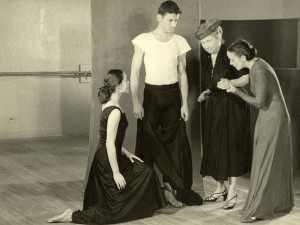The Thinking Body Behind Brainpickings


Image: Perkins School for the Blind Archives via Maria Popova @ Brainpickings
Here’s something for you to think about – or jump about, as it were.
Body Thinking
Helen Keller visited Martha Graham’s studios several times in the 1930s when Merce Cunningham was part of Graham’s troupe. Keller had never danced and even as a girl had never jumped. In fact, when Graham tried to explain to Keller what they were doing, Keller asked Graham, “What is jumping?”
So Graham called Cunningham over and placed Keller’s hands on his body. As he jumped from one position to the next, her hands followed on his body. Her face lit up.
“Oh how wonderful. How like thought!” she said. “How like the mind it is.”
Robert and Michele Root-Bernstein tell this story in their chapter “Body Thinking” from their remarkable book SPARKS OF GENIUS: The 13 Thinking Tools of the World’s Most Creative People. Published in 1999 by Houghton Mifflin, the book merits recognition for assimilating research and examples from a variety of fields. Robert Root-Bernstein, a MacArthur genius grant recipient, is professor at Michigan State University with an emphasis on physiological control systems and the science of creativity.
This chapter “Body Thinking” reiterates the challenge to the creative thinking myth. It also lays groundwork for those scientists dedicated to understanding how gesture, movement, and musculature influence mood and cognition and to those scientists who might even follow correlations between research in creativity and research in yoga.
The Wobble Effect
It seems not incidental a detail from a recent New York Times feature of Maria Popova, the wunder-twenty-something behind the curated blog BrainPickings. Bruce Feiler’s feature emphasizes Popova’s daily regimen and discipline. Apparently the brain picker wobbles while she thinks:
“A fierce creature of habit, she begins every day by working out. On this morning, she alternates 20 chin-ups with 50 push-ups, then performs a series of planks and stretches. Once on the elliptical, she frantically highlights an obscure 1976 book, “The Creativity Question” (Amazon sales ranking: one million-plus), and checks her RSS feed on her iPad.
Exactly 70 minutes later, she returns to her modest one-bedroom apartment to write a brief essay about Freud and daydreaming, file her thrice-daily blog entries and schedule her regimen of 50 Twitter messages a day. She does this while balancing on a wobble board.
“I try to sit still when I work, but my mind goes spiraling elsewhere,” she said in a mild Slavic accent reminiscent of Bond girls in the 1970s. “When my body is moving, it’s almost like it takes the wind out of this mental spinning, and I’m able to focus.” Recently, she came upon a 1942 book on inspiration chronicling others with the same habit. “Mark Twain paced while he dictated,” she said. “Beethoven walked along the river. Maybe there’s a psycho-biological element.”
Maybe.
Coincidentally, or not, while corroborating details online, I discovered Popova recently posted about this same story referenced in another book and includes delightful video footage.
DROP BY
What do you think? How do we sedentary tribes plug in our bodies for creating and thinking? How do you engage movement or physical exercise or regimen as part of your thinking and creating?
See you in the woods,
Jeffrey